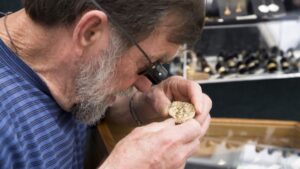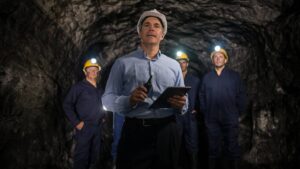Ground Breakers: Canadian adventure still a struggle for gold miner Evolution

Pic: Getty
Aussie gold miner Evolution Mining (ASX:EVN) has weathered a combined storm of Covid absenteeism at its east coast mines and labour shortages in WA in the December quarter but its Red Lake mine in Canada continues to weigh the company down.
Evolution produced 148,084oz of gold in the December quarter at lower all in sustaining costs of $1,347/oz, led by a big fall in costs from sustaining capex at the flagship Cowal mine in New South Wales, despite as much as 15% of its workforce being absent at times after contracting Covid or isolating as close contacts.
That was down from 170,681oz at $1413/oz in the September quarter, along with lower silver and copper production, but generated a 5% increase in operating mine cash flow to $202.7 million despite the sale of the Mt Carlton mine to Navarre Minerals (ASX:NML).
The Mungari operations in WA benefitted from higher grades from its recently acquired Kundana mines, delivering 34,412 oz of gold at a lower AISC of $1,829/oz, but EVN is struggling to fill roles left open because of WA’s border related labour shortages.
Evolution biggest issues remain however at its Red Lake mine in Ontario, Canada, which remain a reno job more than two years on from their US$375m purchase from Newmont Goldcorp in 2019 (US$650m when the adjacent Battle North asset is included).
Red Lake delivered 19,832oz of gold at an AISC of $3,060/oz, a big drop from 23,768oz at $2,697/oz. 15% of its workforce was unavailable at times at Red Lake due to Covid as well.
EVN is not alone in its struggles to bed down operations on the other side of the world in North America.
St Barbara (ASX:SBM) this week revealed a big drop in guidance for its Atlantic Gold operations in Canada, while Northern Star’s (ASX:NST) Pogo mine in Alaska remains the most challenging aspect of its portfolio.
Evolution Mining share price today:
Rising copper prices bring upside for EVN after Ernest Henry purchase
While Red Lake remains a key issue for Evolution, it still expects to hit its guidance of 670,000–725,000oz at $1135-1195/oz in FY22 despite tracking short on both metrics at the half-year mark.
RBC analyst Alexander Barkley says EVN will be supported by higher than expected copper prices, which are trading near record highs, after paying $1 billion to take the share it didn’t own off Glencore.
That deal was finalised on January 6, with Evolution expecting a big drop in costs from an increase in copper credits after turning over costs of negative $882/oz in the December quarter.
Barkley said Ernest Henry could mask cost issues at other mines, but expects EVN to miss guidance after a relatively weak quarter.
“No changes to any guidance, we had believed FY22 site guidance at Ernest Henry and Red Lake could be changed,” he said in a client note.
“At Red Lake, Q2 was weaker than even negative pre-result EVN commentary and we expect it will miss FY22 guidance on both gold and AISC. Given our forecasts for FY22 copper A$12,160/t, above EVN at A$11,000/t, we expect EVN will received a significant AISC benefit at the group level thanks to Ernest Henry by-product credits.”
“This could help mask any cost issues at other mines, namely at Red Lake which appears to be having another difficult year. Ongoing issues at Red Lake could be negative for the market’s longer-term site forecasts and valuation (23% RBCe site value).”
Gold will be strong, Klein
Evolution stock tumbled by more than 12% early doors on the weaker production numbers and a big drop in gold stocks generally after US Fed chair Jerome Powell confirmed the likelihood of interest rate rises to tame runaway inflation from March.
But EVN boss Jake Klein presented the news with a brave face, saying gold remained a standout commodity despite jitters that have impacted gold miners since the start of 2021.
“The gold price is over $2500/oz. I did reflect on the fact that when I started in the industry it was $300/oz, so if we’re not happy at $2500/oz we need to find another sector to operate in,” he said on a conference call.
“The Fed Reserve meeting this morning told everyone what they knew, interest rates are going to go up, I didn’t see anything people should have been surprised about in that meeting.”
“The question which everyone’s asking, Jerome Powell … made the point this morning that inflation is way higher than their target and they need to start raising interest rates and reduce their balance sheet.”
“Is the Fed going to be able to do that … in a way that is not disruptive? If I was someone who needed insurance I’d be buying gold and gold stocks, like Evolution.”
Meanwhile, he said WA’s Government is “deferring the inevitable” by keeping its border shut to the outside with Klein and other Evolution higher up frustrated at labour shortages impacting the Mungari operations and their inability to travel to the site for the bulk of the past two years.
It remains the only site, ironically, that Klein and the miner’s Sydney based executives can’t visit after the reopening of the international border enabled travel to Red Lake from late last year.
“It seems like you’re in some ways deferring the inevitable by keeping it closed,” he said.
“As I said earlier unless there is a cure, which is not on the horizon, it is going to be present and it is going to have to be dealt with at some point in time even if it is deferred, it’s not going to be eliminated.”
“It does feel like other places like New South Wales and Ontario and the rest of the world are learning how to manage this and certainly at our operations while it has been a distraction we have been able to manage through it and we are getting more comfortable that we can manage it.”
An Omicron outbreak has started to emerge in WA in recent days, with the mining industry seeing its first impacts as several staff at Albemarle’s under construction Kemerton lithium hydroxide plant contracted the disease.
The project has already been delayed numerous times amid volatile lithium prices and labour shortages.
Lithium and iron ore miner MinRes (ASX:MIN), which owns 40% of the project was down 8.33% this morning despite a 0.5% run in iron ore prices to US$137.50/t that saw Rio Tinto (ASX:RIO), BHP (ASX:BHP), and Champion Iron (ASX:CIA) all move higher. FMG (ASX:FMG) was down 1.5% at 1pm AEDT.
Silver Lake falls as Harte Gold deal progresses
Also moving into Canada is Silver Lake, which will pick up the high grade Sugar Zone mine in its US$128 million mop up of the assets of Canada’s Harte Gold subject to court approval.
It delivered 64,009oz gold and 243t copper (65,148oz AuEq) with sales of 62,549oz gold and 239t copper at a sales price of A$2,436/oz and AISC of A$1,633/oz in the December quarter.
Higher costs at the Mt Monger mine near Kalgoorlie were anchored by the lower cost Deflector operations in WA’s Mid West, where production hit a quarterly record of 31,838oz gold and 243t of copper.
Silver Lake, which suffered a big fall this morning as gold stocks tumbled, has $274 million in the bank after $101.9m of outflows associated with the Harte Gold deal.
It says once the deal clears it will undertake a strategic review covering operations, exploration and growth potential at the Sugar Zone mine and its regional land package.
Silver Lake share price today:
Borders brew uncertainty around OZ Minerals’ West Musgrave nickel mine
OZ Minerals (ASX:OZL) boss Andrew Cole says a decision on the miner’s massive new nickel and copper mine on the WA border, the West Musgrave project, could be impacted by border restrictions in and out of WA along with rising supply chain costs.
The most recent estimate delivered by OZ in December 2020 put a $1.1 billion price on developing the nickel sulphide orebody on the WA-SA border, one of the most remote mining developments in Australia.
Found by Western Mining Corporation in the late 1990s, OZ took out junior Cassini Resources in 2020 to secure full ownership of West Musgrave, which contains around 1.2Mt of nickel metal and 1.3Mt of copper in resources, albeit at low grades.
The company plans to make an investment decision in the back end of 2022, but has been frustrated by the continued closure of the WA-SA border, with supply chain costs like steel and freight also expected to be higher than its PFS estimates.
“We’re very comfortable and very happy with the way the project is progressing in terms of the technical scoping, scheduling, budgeting etc.,” Cole said.
“In terms of making a decision we would only commit to a project we believe we can deliver on budget and on schedule.
“We are accounting for inflationary impacts on the project as we speak, so we have recosted the elements of the West Musgrave project, especially where steel, concrete, freight and piping are concerned.
“The big unknown is the WA border, for us to be able to make a decision to execute West Musgrave we need an open border.
“We need to be able to move people in and out of the State and get them into the region to actually construct. We’re doing a lot of work on sourcing contracting workforces and partners from Western Australia, but the reality is not all of them can come from Western Australia.
“There are foreign, overseas contributors to a project like this, there are interstate contributors … so that is a prerequisite.”
Cole said OZ is still progressing the project in the expectation it will be able to make a decision in the second half.
OZ produced 32,169t of copper and 58,306oz of gold across its SA and Brazilian projects in the December quarter at AISC of US$1.596/t, hitting the lower end of its 120,000-145,000t copper guidance for 2021 with 125,486t of copper and 237,263oz of gold for the year at AISC of US$1.343/t, within its US$1.25-1.40/t range.
The copper miner delivered record operating revenue of $2.1 billion for 2021 on super high prices for the hot commodity.
OZ Minerals share price today:

UNLOCK INSIGHTS
Discover the untold stories of emerging ASX stocks.
Daily news and expert analysis, it's free to subscribe.
By proceeding, you confirm you understand that we handle personal information in accordance with our Privacy Policy.








